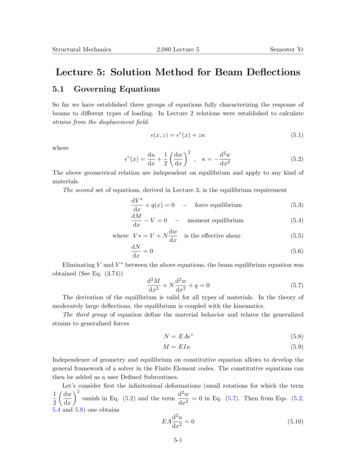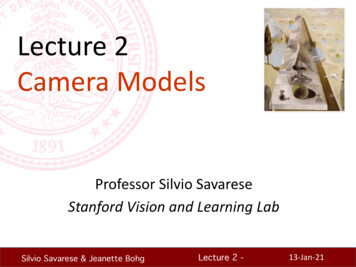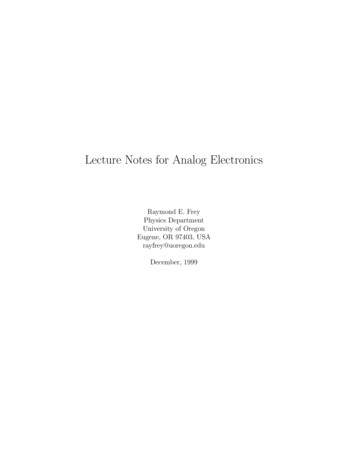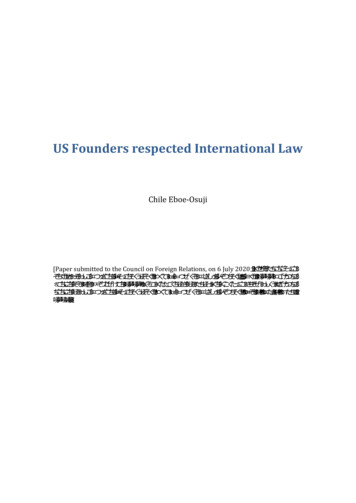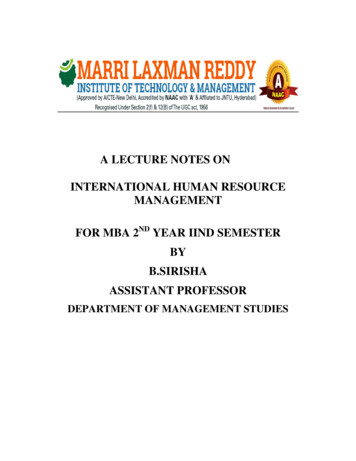
Transcription
A LECTURE NOTES ONINTERNATIONAL HUMAN RESOURCEMANAGEMENTFOR MBA 2ND YEAR IIND SEMESTERBYB.SIRISHAASSISTANT PROFESSORDEPARTMENT OF MANAGEMENT STUDIES
JAWAHARLAL NEHRU TECHNOLOGICAL UNIVERSITY HYDERABADMBA INTERNATIONAL HUMAN RESOURCE MANAGEMENTUnit – I Introduction to IHRM: Basics of IHRM Importance - Definition, Nature, Scope and componentsof IHRM Strategy, Functions, difference between Domestic HRM and IRHM, Over view of InternationalHR activities- HR planning, Recruitment, Selection, Training and Development, PerformanceManagement, Remuneration, Repatriation, Employee Relations, Approaches to the study ofemployment policy across countries.Unit – II International Recruitment and Selection: Approaches to international Recruitmentethnocentric, polycentric, geocentric, region-centric; Selection process-factors effecting in expatriateselection process, Technical ability, cross-cultural suitability, individual adjustments, family adjustmentsIHRM practices – USA, UK, Japan and India A comparative studyUnit – III: Managing HRM In Virtual Organization, Globalization & HRM: Meaning, Features and Typesof Virtual Organizations, Advantages and disadvantages, Managing HR in Virtual Organizations; Impactof Globalization on Employment, HRD, Wage& Benefits, Collective Bargaining, ParticipativeManagement, Ethical Issues in HRUNIT-IV: IHRM Model of India: Culture and Indian Managers- Indian Managers-Responses to HRpractices across the world-Implication for multinationals – MNCs skill based approach and staff trainingand Development priority – The global managers and future organizations - India’s Response toUniversalization of HR Principles, Policies and Practices – Cross- Convergence.UNIT-V: Special Issues in IHRM: Challenges of Globalization and implications of Managing people andleveraging Human Resources for competitive advantage – Impact of IT on Human ResourceManagement- IT and HR- out sourcing HR-Globalization, Quality of Work life and productivityReorientingwork force through HR Interventions – Women expatriates and their problems – Exit policy andpractices – Impact on participative Management and Quality circles.REFERENCES: 1. N. Sengupta&Mousumi, S.Bhattacharya, International HRM, Excel Books2. P.L. Rao, International Human Resource Management – Text and Cases, Revised Edition, Excel BooksNew Delhi3. Edwards - International HRM, Pearson Education.4. K. Aswathappa - International Human Resource Management Sadhna Dash Text and Cases, TataMcGraw Hill Publishing Company Ltd5. P. Subba Rao, International Human Resource Management Himalaya Publishing House Dr. NilanjamSengupta- International Human Resource Management Excel Books, New Delhi
6. Charles M. Vance, Managing a Global Workforce, challenges and opportunities in IHRM PHI-PrivateLtd, New Delhi – 2007.UNIT-1
Introduction of Human Resource Management (HRM) and IHRMIHRM is set of organizational activities aimed at effectively managing and directing humanresources/labour towards achieving organizational goals. Typical functions performed by HRMstaff would be recruitment, selection, training and development, performance appraisal,dismissal, managing promotions and so on.Then what is International Human Resource Management (IHRM)?IHRM can be defined as set of activities aimed managing organizational human resources atinternational level to achieve organizational objectives and achieve competitive advantage overcompetitors at national and international level. IHRM includes typical HRM functions such asrecruitment, selection, training and development, performance appraisal and dismissal done atinternational level and additional activities such as global skills management, expatriatemanagement and so on.In simple terms, IHRM is concerned about managing human resources at MultinationalCompanies (MNC) and it involves managing 03 types of employees namely,1. Home country employees- Employees belonging to home country of the firm where thecorporate head quarter is situated.2. Host country employees- Employees belonging to the nation in which the subsidiary issituated.3. Third country employees- These are the employees who are not from home country/hostcountry but are employed at subsidiary or corporate head quarters. As an example aAmerican MNC which has a subsidiary at India may employ a French person as the CEO tothe subsidiary. The Frenchman employed is a third country employee.Basics of International Human resource managementInternational Human resource management is the process of procuring allocating and effectivelyutilizing the human resources in a multinational corporation. While HR Managers in theseorganization have to integrate HR policies and practices across a number of subsidiaries spreadin several countries so that the organization goals can be achieve at the same time they have tomake these policies and practices sufficiently flexible to allow significant differences in thesepolicies in different countries.International HRM is concerned with identifying and understanding how the MNC‘s managetheir geographically dispersed worked force in order to leverage their HR resources for obtaininglocal as well as global competitive advantage.
Definition of IHRMBoxall, P. (1992) defined International Human Resource Management (IHRM) as 'concernedwith the human resource problems of multinational firms in foreign subsidiaries (such asexpatriate management) or more broadly, with the unfolding HRM issues that are associated withthe various stages of the internationalisation process. (Boxhall, P. 1992).Mark Mendenhall (2000) sought to be more specific by outlining a number of criteria relevant toa definition of IHRM.IHRM is concerned with HRM issues that cross national boundaries or are conducted inlocations other than the home country headquarters.IHRM is concerned with the relationships between the HRM activities of organisations and theforeign environments in which the organisations operate.IHRM includes comparative HRM studies; e.g. differences in how companies in Japan, Thailand,Austria and Switzerland plan for upgrading of employee skills and so on.Importance of IHRMThe importance of international human resource management is getting increase everyday as wehave globalisation and internationalisation over the world. As a result, numbers of themultinational companies are getting increase. According to Brewster et al. (2007), themultinational companies are increasing and there is economic dominance as 80% of theindustrial output for the world is produce by the world's 1,000 largest companies. Brewster et al.(2007) also mentioned that as the number of multinational company increases, globaltransferring is increasing such as sending works between team members of the company basedeverywhere over the world. In addition, through this trend, diversity is increasing within theorganisation and the multiculturalism must be carefully considered by the organisation to utiliseits human resources effectively in their organisation.The one of crucial role of human resource manager is developing effective human resourcemanagement policies and practices for organisation such as recruitment, reward, training,development, flexibility, work-life balance, employee relations and communications (Brewster etal, 2007). However, these policies and practices can be varied between national cultures.Rosenzweig and Nohria (1994) argued 'that HR is the area of management most likely to besubject to national differences' (Cited in Brewster et al, 2007).
In these days, many large companies are trying to expand the company from their own countryof origin to all over the world. These multinational companies are all facing same issues, whichare developing policies and practices for the human resource management in their subsidiaryoverseas operations. In this paper, as a senior human resource manager of a multinationalcompany in the Great Britain, will be discussed the main factors which will be considered whiledeveloping policies and practices for subsidiary in Latin America and also differences of policiesand practices between the UK and the Latin America subsidiary operations.Human Resource Management FeaturesHuman ResourceManagement is a process of bringing people and organizations together so thatthe goals of each are met. The various features of HRM include: It is pervasive in nature as it is present in all enterprises. Its focus is on results rather than on rules. It tries to help employees develop their potential fully. It encourages employees to give their best to the organization. It is all about people at work, both as individuals and groups. It tries to put people on assigned jobs in order to produce good results. It helps an organization meet its goals in the future by providing for competent and wellmotivated employees. It tries to build and maintain cordial relations between people working at various levels in theorganization. It is a multi-disciplinary activity, utilizing knowledge and inputs drawn from psychology,economics, etc.International Human Resource Management: Nature and ScopeHuman ResourceManagement is a process of bringing people and organizations together so thatthe goals of each are met. The various features of HRM include: It is pervasive in nature as it is present in all enterprises. Its focus is on results rather than on rules. It tries to help employees develop their potential fully. It encourages employees to give their best to the organization.
It is all about people at work, both as individuals and groups. It tries to put people on assigned jobs in order to produce good results. It helps an organization meet its goals in the future by providing for competent and wellmotivated employees. It tries to build and maintain cordial relations between people working at various levels in theorganization. It is a multi-disciplinary activity, utilizing knowledge and inputs drawn from psychology,economics, etc.The scope of HRM1. Personnel aspect-This is concerned with manpower planning, recruitment, selection,placement, transfer, promotion, training and development, layoff and retrenchment,remuneration, incentives, productivity etc.2. Welfare aspect-It deals with working conditions and amenities such as canteens, cr?ches, restand lunch rooms, housing, transport, medical assistance, education, health and safety,recreation facilities, etc.3. Industrial relations aspect-This covers union-management relations, joint consultation,collective bargaining, grievance and disciplinary procedures, settlement of disputes, etc.Functins of IHRMGlobalization, the process of integrating a business's operations and strategies across a widearray of cultures, products and ideas, is having an impact on the role of human resourcemanagers. Once concerned with the impact of local issues on employees, human resources mustnow consider the effects of workforce diversity, legal restrictions and the interdependencebetween training and professional development on the organization. As such, the five mainfunctions of global human resource management are vital concepts to the strategic operation of abusiness.RecruitmentAttracting, hiring and retaining a skilled workforce is perhaps the most basic of the humanresources functions. There are several elements to this task including developing a jobdescription, interviewing candidates, making offers and negotiating salaries and benefits.
Companies that recognize the value of their people place a significant amount of stock in therecruitment function of HR. There is good reason for this -- having a solid team of employeescan raise the company's profile, help it to achieve profitability and keep it running effectively andefficiently.TrainingEven when an organization hires skilled employees, there is normally some level of on-the-jobtraining that the human resources department is responsible for providing. This is because everyorganization performs tasks in a slightly different way. One company might use computersoftware differently from another, or it may have a different timekeeping method. Whatever thespecific processes of the organization, human resources has a main function in providing thistraining to the staff. The training function is amplified when the organization is running globaloperations in a number of different locations. Having streamlined processes across thoselocations makes communication and the sharing of resources a much more manageable task.Professional DevelopmentClosely related to training is HR's function in professional development. But whereas trainingneeds are centered around the organization's processes and procedures, professional developmentis about providing employees with opportunities for growth and education on an individual basis.Many human resource departments offer professional development opportunities to theiremployees by sponsoring them to visit conferences, external skills training days or trade shows.The result is a win-win: it helps the employee feel like she is a vital and cared-for part of theteam and the organization benefits from the employee's added skill set and motivation.Benefits and CompensationWhile the management of benefits and compensation is a given for human resources, theglobalization of companies in the twenty-first century has meant that HR must now adapt to newways of providing benefits to an organization's employees. Non-traditional benefits such asflexible working hours, paternity leave, extended vacation time and telecommuting are ways tomotivate existing employees and to attract and retain new skilled employees. Balancingcompensation and benefits for the organization's workforce is an important HR function becauseit requires a sensitivity to the wants and needs of a diverse group of people.Ensuring Legal Compliance
The final function of human resource management is perhaps the least glamorous but arguably ofutmost importance. Ensuring legal compliance with labor and tax law is a vital part of ensuringthe organization's continued existence. The federal government as well as the state and localgovernment where the business operates impose mandates on companies regarding the workinghours of employees, tax allowances, required break times and working hours, minimum wageamounts and policies on discrimination. Being aware of these laws and policies and working tokeep the organization completely legal at all times is an essential role of human resources.Differences between domestic HRM and International HRM (IHRM)are summarized below: Domestic HRM is done at national level and IHRM is done at international level.Domestic HRM is concerned with managing employees belonging to one nation and IHRMis concerned with managing employees belonging to many nations (Home country, hostcountry and third country employees)Domestic HRM is concerned with managing limited number of HRM activities at nationallevel and IHRM has concerned with managing additional activities such asexpatriate management.Domestic HRM is less complicated due to less influence from the external environment.IHRM is very complicated as it is affected heavily by external factors such as culturaldistance and institutional factors.IHRM and training and developmentTraining and development increases in complexity as MNEs move abroad.Types of training and development depend on a number of factors:The degree to which management is centralized.The types of workers employed in subsidiaries or joint ventures.The importance of branding, and the extent to which employees are expected to reflect the brand.The cultural expectations of training.In a global company, the training may well be centralised so that suppliers, employees anddistributors are aware of the brand image that needs to be communicated.E.g. in Ford training programmes are set up centrally, and then translated and delivered to allmain suppliers, subsidiaries and distributors.
If, however, a more polycentric approach is taken, then the training may well be far more local,and more in line with the local cultureInternational Human resource management Performance managementPerformance management (PM) is a very important process of human resource management(HRM), in general. It implies an assessment of current or previous results or performance of theemployee, team or the whole organization. It is a base for many business practices related toHRM:the need for staff training, new recruitment, career development, rewarding, etc. A wideliteraturesources emphasized that PM is a complex process, especially when the global market is in thescopeof the researchInternational Human resource management compensationLet's start our discussion of Compensation Management with a simple question: "What iscompensation?" In very simple terms, compensation is the results or rewards that the employeesreceive in return for their work.Compensation includes payments like bonuses, profit sharing, overtime pay, recognitionrewards and sales commission, etc.Compensation can also include non-monetary perks like a company-paid car, company-paidhousing and stock opportunities. Compensation is a vital part of human resource management,which helps in encouraging the employees and improving organizational effectiveness.From a manager's point of view, the compensation package offered to a company's employees isessential not only because it costs money, but because it is likely to be the primary reason theemployees work for the firm.Compensation packages with good pay and advantages can help attract and retain the bestemployees. A quick survey of employees about compensation is likely to expose an expectation
that wages are fair and cover basic living expenses, keep up with inflation, leave some moneyfor savings (perhaps for retirement) and leisure, increment over time.A company's compensation scheme also informs a great deal about the firm's values andcultures. Employees often look at what a company pays rather than what it says. In manyaspects, people behave as they are rewarded.A compensation scheme projects what the company expects of its employees. For example, ifquality is an essential value, then it should be implemented through some element of the totalcompensation system.International Human resource management Employee relationsHuman resource management and employment relations are at the heart of any modernorganisation. Our Human Resource Management and Employment Relations major focuses onunderstanding people and relationships at work – what makes organisations work, whatmotivates employees, and what the future of work could be.You explore how employees, employers, government and trade unions shape people‘sexperience of work and the outcomes from work. Choose from a wide range of papers to tailoryour study to your interests. You can investigate the relationship between strategic humanresource management and organisational performance, inequalities in work and organisations,and ways to build inclusiveness in organisational life. You can also explore employmentregulation issues, negotiation and conflict management, strategic career management; and workrelated injuries and illness, and how to prevent them.Approaches to international policy across countriesHuman resource policies are the formal rules and guidelines that businesses put in place to hire,train, assess, and reward the members of their workforce. These policies, when organized anddisseminated in an easily used form, can serve to preempt many misunderstandings betweenemployees and employers about their rights and obligations in the business place. It is tempting,as a new small business owner, to focus on the concerns of the business at hand, and put off thetask of writing up a human resource policy. All business analysts and employment lawyers willadvise a new business owner to get a policy down on paper, even if it is a simple one draftedfrom a boilerplate model. Having policies written is important so that it is clear to all what thepolicies are and that they are applied consistently and fairly across the organization. Moreover,
when issues concerning employee rights and company policies come before federal and statecourts, it is standard practice to assume that the company's human resource policies, whetherwritten or verbal, are a part of an employment contract between the employee and the company.Without clearly written policies, the company is at a disadvantage.Small businesses—and especially business startups—can not afford to fritter away valuable timeand resources on drawn-out policy disputes or potentially expensive lawsuits. Having a humanresource policy in place from the start can help to avoid this situation. The business owner whotakes the time to establish sound, comprehensive human resource policies will be far betterequipped to succeed over the long run than the business owner who deals with each policydecision as it erupts. The latter ad hoc style is much more likely to produce inconsistent,uninformed, and legally questionable decisions that may cripple an otherwise prosperousbusiness. For as many small business consultants state, human resource policies that areinconsistently applied or based on faulty or incomplete data will almost inevitably result indeclines in worker morale, deterioration in employee loyalty, and increased vulnerability to legalpenalties. To help ensure that personnel management policies are applied fairly, business ownersand consultants alike recommend that small business enterprises produce and maintain a writtenrecord of its HR policies and of instances in which those policies came into play.
UNITIIInternational Recruitment and selection processwhile recruiting people for international operations, the international HR managers must identifythe global competitiveness of the potential applicants at the time of the recruiting process. It isessential that the workforce of an international organization is aware of the nuances ofinternational business. Understandably, the company must keep international knowledge andexperience as criteria in the recruitment and selection process.12 Besides, the international HR
department must have a fairly good idea about the skills and availability of human resources indifferent labour markets in the world. The HR department must have the capacity to foresee thechanges in these markets and exploit those changes productively. A truly international HRdepartment would insist on hiring people from all over the world and place them throughout n.Approaches to Recruitment in IHRM Though the general aim of any recruitment policy is toselect the right people for the right task at the right time, the HR department of internationalcompanies may adopt one of the following three specific approaches available for recruitingemployees for global operations.EthnocentricapproachWhen a company follows the strategy of choosing only from the citizens of the parent country towork in host nations, it is called an ethnocentric approach. Normally, higher-level foreignpositions are filled with expatriate employees from the parent country. The general rationalebehind the ethnocentric approach is that the staff from the parent country would represent theinterests of the headquarters effectively and link well with the parent country. The recruitmentprocess in this method involves four stages: self-selection, creating a candidate pool, technicalskills assessment, and making a mutual decision. Self-selection involves the decision by theemployee about his future course of action in the international arena. In the next stage, theemployee database is prepared according to the manpower requirement of the company forinternational operations. Then the database is analysed for choosing the best and most suitablepersons for global assignments and this process is called technical skills assessment. Finally, thebest candidate is identified for foreign assignment and sent abroad with his consent.The ethnocentric approach places natives of the home country of a business in key positions athome and abroad. In this example, the U.S. parent company places natives from the UnitedStates in key positions in both the United States and Mexico.PolycentricapproachWhen a company adopts the strategy of limiting recruitment to the nationals of the host country(local people), it is called a polycentric approach. The purpose of adopting this approach is toreduce the cost of foreign operations gradually. Even those organizations which initially adoptthe ethnocentric approach may eventually switch over lo the polycentric approach. The primarypurpose of handing over the management to the local people is to ensure that the companyunderstands the local market conditions, political scenario, cultural and legal requirements better.The companies that adopt this method normally have a localized HR department, which managesthe human resources of the company in that country. Many international companies operatingtheir branches in advanced countries like Britain and Japan predominantly adopt this approachfor recruiting executives lo manage the branches."The polycenlric approach uses natives of the host country to manage operations in their countryand natives of the parent country to manage in the home office. In this example, the Australian
parent company uses natives of India to manage operations at the Indian subsidiary. Natives ofAustralia manage the home office.GeocentricapproachWhen a company adopts the strategy of recruiting the most suitable persons for the positionsavailable in it, irrespective of their nationalities, it is called a geocentric approach. Companiesthat are truly global in nature adopt this approach since it utilizes a globally integrated businessstrategy. Since the HR operations are constrained by several factors like political and ethnicalfactors and government laws, it is difficult to adopt this approach. However, large internationalcompanies generally adopt the geocentric strategy with considerable success.For international recruitment, especially on foreign soil, organizations generally use manpoweragencies or consultants with international connections and repute to source candidates, inaddition to the conventional sources. For an effective utilization of the internal source ofrecruitment, global companies need to develop an internal database of employees and aneffective tracking system to identify the most suitable persons for global postings.The geocentric approach uses Ihe best available managers for a business without regard for theircountry of origin. In this example, the UK parent company uses natives of many countries entricApproachCompany's international business is divided into international geographic regions. Theregiocentric approach uses managers from various countries within the geographic regions ofbusiness. Although the managers operate relatively independently in the region, they are notnormallymovedtothecompanyheadquarters.The regiocentric approach is adaptable to the company and product strategies. When regionalexpertise is needed, natives of the region are hired. If product knowledge is crucial, then parentcountry nationals, who have ready access to corporate sources of information, can be brought in.One shortcoming of the regiocentric approach is that managers from the region may notunderstand the view of the managers at headquarters. Also, corporate headquarters may notemploy enough managers with international experience.The regiocentric approach places managers from various countries within geographic regions ofa business. In this example, the U.S. parent company uses natives of the United States atcompany headquarters. Natives of European countries are used to manage the Italian subsidiary.International Selection processEven though cultural differences influence the selection procedure to some extent, organizationstend to follow similar criteria and methods worldwide. This is due to the fact that the endobjective of any selection process is to choose the most capable persons for the job. The
selection criteria for international jobs usually revolve around the five core areas of behaviour,attitudes, skills, motivation and personality. More specifically, the focus of selection forinternational operations normally includes cultural adaptability, strong communication skills,technical competence, professional or technical expertise, global experience, country-specificexperience, interpersonal skills, language skills, and family flexibility. Employers around theworld usually rank personal interviews, technical competency and work experience in similarjobsasimportantcriteriaforselection highly developed technical skillsgood language and communication skillstolerance towards other culture, race, creed, colour, habits, and valueshigh level of motivationstress resistancegoal-oriented behaviourFinally, at the time of selection for international assignments, an organization should aspiringfortheglobaljob.Expatriate Selection ProcessThe results of the interviews indicate that the majority of the respondents(87%) still placed extreme importance on the technical competence oftheir expatriates, with (47%) acknowledging personality traits, relationalabilities and motivational state to be highly important criteria. Overall,the participating companies considered the family situation asmoderately important, language skills as somewhat unimportant andprior expatriate experience as moderately unimportant. Therefore, thevalue of language skills and prior overseas experience was dismissed byrespondents as relatively unimportant in the area of selection. However,it was noted that previous overseas experience reduced the need fororientation.Responses from the interviews suggest that techni
It is a multi-disciplinary activity, utilizing knowledge and inputs drawn from psychology, economics, etc. International Human Resource Management: Nature and Scope Human ResourceManagement is a process of bringing people and organizations together so that the go





